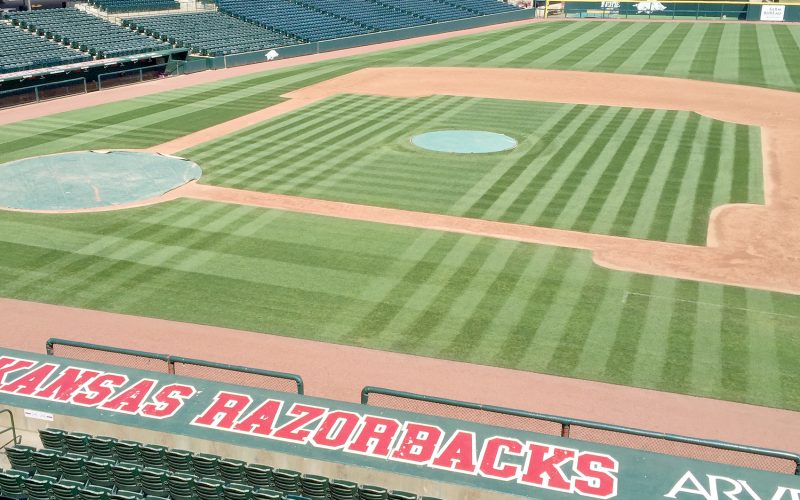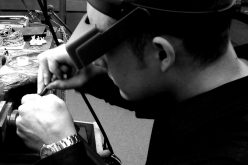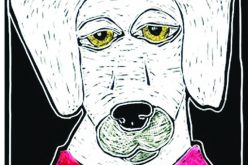
Courtesy Photo | Blake Anderson, the assistant director of sports turf operations at the University of Arkansas, won a national first place award for his mowing patterns at Baum Field. The field is home to the Arkansas Razorbacks baseball team.
The next time you call the Hogs during a home game at Baum Stadium, be sure to also shout “Woo pig soooie, Winners of the Sports Turf Managers Association’s third annual ‘Mowing Patterns Contest’ — Razorbacks!”
That may be a mouthful, but it’s the truth. Blake Anderson, the assistant director of sports turf operations for the University of Arkansas, recently won the national award for the best looking mowing pattern in the country, which won by popular vote for its classic look. It’s the photo on the cover of this week’s Free Weekly.
All sports turfs, whether they were for soccer, football, baseball or what have you, from city parks to high schools to colleges were under consideration and Anderson’s design won out.
Maintaining a baseball field is no simple task. There’s many tools of the trade and several long days work that involves raking the baseball diamond dirt every so often during baseball games. Sometimes players’ cleats tear out chunks of grass, so turf managers have to doctor the spot up with a cut from a grass sod farm. Sometimes grass doesn’t grow, so a turf blanket has to be applied which acts as a greenhouse to keep the ground warm.

Staff Photo Nick Brothers |Blake Anderson demonstrates the roller push mower that is used infield at Baum Stadium. The mower can be used to cut grass shorter than an inch, and the rolling mechanism allows for patterns to be mowed.
The baseball team is also doing relatively well this season. It’s possible that may correlate with the awesome turf they play on (we can neither deny or confirm).
Here’s our interview with Anderson, the man behind Baum field’s quality:
TFW: So how do you get into a job like turf management?
ANDERSON: I got a scholarship to play baseball at Eastern Kentucky as a pitcher. I thought I was going to go pro and make the major leagues, but then my arm gave out about my junior year. My degree was sports management. I wanted to be like an athletic director or coach if baseball didn’t work out. I had to do an internship and tried to get one with a minor league team in Lexington. They were out of positions for the front office but they offered me one with the turf management team.
I ended up taking it and ended up loving it. I still wanted to stay in baseball and it kept me in it. The golf course guys would like you to have a sports turf degree, but for people like me it’s a lot of hard work and being interested.
You have to be open to traveling. I worked for the Atlanta Braves in a seasonal position for a while while working full time at a prestigious high school in Atlanta. There’s only like 30 teams and each team maybe has a handful of groundskeepers, so you’re looking at maybe 100 jobs and once people get them they want to stay there.
Working in the Major Leagues is what I consider to be the most prestigious position in the industry, but after that I’d say it’s the SEC. When this job opened up I had recently gotten married and fixing to have a child so I thought this would be a good place to work and not as demanding as a job elsewhere.

Staff Photo Nick Brothers Blake Anderson mows the outfield of Baum Stadium atop his triplex riding mower. The three mowing mechanisms utilize a roller to flatten the grass in a certain pattern, similar to the way leather or microfiber appears after brushing it.
TFW: Sounds like there’s a pretty good network of people in the industry.
ANDERSON: Yeah, definitely. I still keep in contact with my former bosses and former crew members. We’re always on Twitter asking each other questions and suggesting different products to use. Every year groundskeepers in the Sports Turf Management Association organize a first of the year conference. Sports turf managers there will share their experiences and what’s worked for them. There’s an expo for products to use, too.
TFW: What’s unique to baseball field turf management?
ANDERSON: A lot of that has to deal with the amount of fields and people available to take care of a given situation. There might only be three parks and recreation guys who are going to be in charge of like 10 fields, but in the majors it could be 10 guys in charge of one field. There’s also differences in materials and grass, which the quality and maintenance depends on how many guys you have available.
You’re kind of limited in what you can do. The taller you mow your grass the better it can survive. The coach wants the grass lower, so that’s more water and fertilizer and you’re cutting it more frequently. Different kinds of grasses require different care, and there’s more and more work for the higher you go.
The big part of how the field looks depends on the stadium’s quality. You could have Baum field at a small high school, but it’d cost you. The big lights and the fences kinda change your perspective of how the field is. Y’know the players tell me all the time — they’ll come back from a road game and tell me how their field didn’t feel as good as ours. You can definitely tell a difference in how the ball rolls on the grass and the quality of the dirt.

Staff Photo Nick Brothers | To keep a field like the one at Baum stadium looking good, many tools and rakes are used to keep surfaces level and clean for maximum playability.
TFW: So, as far as mowing designs go, is that just left up to you?
ANDERSON: Yeah, it’s kind of left up [to me]. I just like to keep straight lines instead of circles or squiggly lines. What can happen if you mow the same pattern too many times … is the grass will stay that way and the ball could roll and snake across the pattern.
Some guys like to mow patterns that go straight to the outfield positions so the ball rolls straight. That’s not really much of a big deal for me because we switch up our pattern every weekend or so.
TFW: How often do you mow unique shapes or patterns into the field?
ANDERSON: The special designs kinda comes with having more time. It puts more stress on the grass if you’re doing it five or six times to emphasize the design pattern. I typically try to avoid that. If you’re putting a pattern out in the outfield and your dirt’s not where it should be, you should probably be more concerned about taking care of the dirt.
It’s not that hard, but it takes time when you’re first setting it out there. You want to make sure it’s lined up straight or whatnot. You can use a mower or a broom and push the grass. We have a squeegee with a roller on it. You’d probably cut it one way and push the grass another way to show the light and the dark contrast. It’s like leather or micro- fiber.

Staff Photo Nick Brothers
One of the hardest jobs to keep up with in sports turf management for baseball fields is keeping the diamond dirt hydrated.
You kind of what something a decent size, so you need to do some math. You can put some string in the ground to map it out. It doesn’t have to be perfect. It takes time and people though, and I don’t really have that out here, so I don’t really worry about it too much.
TFW: That award, though. How’s that feel?
ANDERSON: It was put on the STMA, and basically you had to promote yourself if you wanted to get a high amount of votes. Y’know because only people like me would actually see there was a mowing contest. So, I knew we had a good fan base here so I knew we’d do well if we just put it out there and tell people about it. People know what to expect to come here and know the field always looks good.
It felt good to win it, but I mean, it’s just a mowing pattern contest. I think it was more of a helpful boost to the University of Arkansas that might help in the recruiting when they can pitch they have an award winning field.
When a player comes up to me and says — well, not really when they say it’s awesome because I know if the field looks good or not — in baseball it’s when the dirt is playing awesome and the player comes up to you and says “That dirt’s really awesome today.” When we can keep that consistent play in the dirt, that’s what gets me excited. We spend so much time on the home plate and pitcher’s mound. Knowing that the field looks good gets me excited. I’m just doing my job. They know how much I’m out here and how much I care about it.










